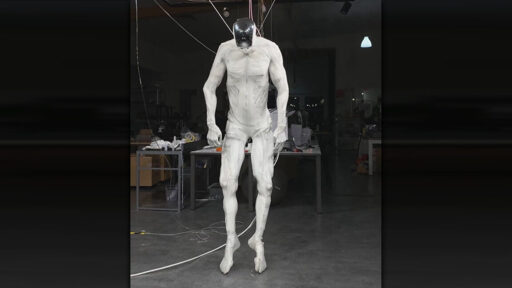- cross-posted to:
- hardware
They really did go for the “horror movie about to go very wrong” aesthetic when they made those videos, didn’t they.
Yeah, what’s up with the music?
Sounds like the creepy in-mission music in the original X:COM
they could have gone so many different directions. nutcracker. river dance. yackety sax…
Seriously?
“Hey, this thing looks kinda creepy, what’s with the creepy music?”
deleted by creator

We really are obsessed with replicating any and all sci-fi cautionary tales, aren’t we?
It’s the Torment Nexus dilemma.
I’m currently using ChatGPT to develop code that I intend to incorporate into my latest version of Roko’s basilisk v0.17.13
It’s clear they made this weird on purpose but still, so many questions…
the robot hangs suspended from the ceiling as its limbs twitch and kick, marking what the company claims is a step toward its goal of creating household-helper robots
Oh yeah, definitely a huge step in that direction…
Clone Robotics designed the Protoclone with a polymer skeleton that replicates 206 human bones
That’s all of the bones of an human adult. Yeah, I’m sure absolutely all of them were necessary.
I don’t understand these companies’ obsession with humanoid robots. A robot doesn’t have to humanoid to be a useful household helper. It doesn’t even have to be humanoid for people to form a friendly bond with it (something I think would be a good quality in a “household helper”) just look at Star Wars droids
Some of this is also about less complicated ways to use patents that can also be applied to things like prosthetic limbs.
Also, it provides a control case with how well-studied human anatomy is. In terms of basic mechanical motion, there’s a clear baseline goal.
I remember seeing early versions of the synthetic muscle fibers years ago, but as far as ways to practically apply them and test, and refine them as control technology improves with machine learning. 10-15 years ago, this wasn’t really possible.
A humanoid robot can operate in the existing world. It can climb stairs and open a door, for example. A robot on wheels without arms can’t do that.
Wouldn’t a quadruped be easier? You can stick arms onto a robotic “dog”.
Crabs make even more sense. 6 legs makes climbing stairs even easier. 2 big arms to hold thing and manipulate doors, drawers etc.
Nature keeps making crabs, we should just cut to the chase.
You could, but it still has to interact with things at and above human height, like stuff on countertops and high shelves.
if you want it to interact with a wide range of environments and objects that were designed for humans, then a humanoid robot may be the way to go.
See also: Cogsworth
It has to be humanoid to live among humans, using human architecture and technology.
Maybe they’re attempting to make it ‘learn’ how to move itself using neural networking instead of programming discrete movement presets.
Ooh yeah let’s hope that’s the case.
the only thing I’m hoping for is that this can serve as a proof of concept that human brains might be able to learn to control limbs made of synthetic muscles like that…
It’s definitely made that accurate/creepy for marketing reasons, they’re probably hoping this will help them get investors. I would also assume you can simplify the human body design a good bit before losing the functionality we actually want from something like this.
How is it going to balance if it does not have a fake cochlea? /s
At first misread as cloaca. Barely even gave me pause in this thread.
That’s all of the bones of an human adult. Yeah, I’m sure absolutely all of them were necessary.
Are you trying to imply they gave it a dick? If so they don’t have bones in them.
No, it’s pretty much only you thinking that. The rest of us were thinking about the 6 tiny bones in the ears only used for hearing or dozens of weird little bones in the wrists and ankles.
Exactly, ear in particular was what I thought about. There are very tiny bones in there. I’m pretty sure they didn’t replicate a functional human ear, so those have no impact on anything.
Many bones in the hand and foot are also locked in place together, so modeling each one seems, well, I don’t think it’s a waste of time, but at this point you’re making an art performance.
Doesn’t mean they didn’t give it a dick though
Hmm, I have some questions to ask myself seemingly
I have literally no idea how that came to your mind immediately. It’s very funny to me that it did though.
Certainly doesn’t need a hyoid bone.
The goal is to replicate humans, so yeah

This kind of thing could actually be really beneficial for prosthetics. If we can make a robot that functions as close as possible to a human body at human size, then we can chunk it up to make prosthetics that work like your original limbs and are easy to adapt to.
Science isn’t about why, it’s about why not!
Now we can have people twitching while hanging from the ceiling without having to hunt them in back alleys! Progress!
Think of the savings in cleaning supplies!
That’s weird they decided to publish this with creepy horror-style sounds.
There is another video, showing only the torso. It has no music, but the actual sound and this is not even less terrifying https://youtu.be/gl0GnzPIOl4

Posted this the last time I saw this article, but it seems to be even more relevant for this video.
We DO have the spear of Longinus available, right? RIGHT?
Not much gets to me, but this shit is fucked up. I bet the people who work on these have horrible nightmares.
Pretty sure I’ve seen this one in a Silent Hill game
Maybe a weird aside, but what does this mean?
pushing fluid at 40 standard liters per minute.
Are there “liters” other than the 10cm x 10cm x 10cm definition?
To totally confuse you: The USA uses the “standard litre” while Europe uses “normal litre”:
Thanks, you succeeded hahaha.
From what I’m reading there this is a measure of mass flow rate of gas, expressed as volume per minute at some standard volume and pressure. Which makes some sense, you need those two parameters to be fixed so you can measure mass by volume.
And then I realized the OP article uses it for a
fluidliquid 😂Aren’t fluids and gases kinda the same thing in some aspects, just different mass? (Clearly, not a scientist).
The major difference is compressibility. Generally, liquids are practically incompressible. So just knowing the mass flow rate and density, volume flow rate can be calculated. It’s not so simple for gases
A fluid is anything that flows. A box of marbles is a fluid.
First of all: Sorry, I made a mistake yesterday. I ment to say liquid but translated it wrong in my head
Now to your question, they are similar in some aspects, that’s what makes gasses and liquids both be considered fluids, so fluid dynamics apply to both for example.
The difference is how much the molecules in the liquid or gas interact: A lot in the liquid, not significantly in most gasses under standard conditions.
And the things is, the SLPM measure apparently relies on a characteristic of ideal gasses, that one mol of gas particles under standard conditions always takes a fixed volume 22.41 l. So now I’m confused why they would use it for hydraulic fluid, which sounds like a liquid to me.
Volume changes based on temperature and pressure. So when we reference volume measurements like for flow rates, we typically do the math to adjust those to standard temperature and pressure. Standard pressure is 1 atm but standard temperature varies based on who you’re talking to because of competing standards. It’s usually 25 C or 20 C.
When we want to reference the non temperature and pressure corrected volume, we append actual to it so that people know what the measurement is. Some people don’t do that and that causes confusion for others using their work if the reading is standard or actual.
You mean the flow rate of a volume of liquid? What are you confused about exactly?
They’re asking why it’s “standard litres per minute”, instead of just “litres per minute”
Oh, well yeah Standard liters per minute or SLM, specifically refers to flow rates measured in the U.S.
So the “other” measurement would evidently be Europes “Normal liters per minute”.
What the difference is, I couldn’t tell you.
I see they are prepping for the live action QWOP movie.
Let’s ensure we also make household robots unreasonably strong and durable. We don’t want shotgun wielding humans to be able to disable one, or barricade in a house.
Bravo scientists for realizing how creepy this is and saying, let’s lean into it.
“At long last, we have created the Torment Nexus from classic sci-fi novel Don’t Create The Torment Nexus”
I don’t like living in the future as much as young me thought I would.

A 500-watt electric pump serves as the robot’s “heart,” pushing fluid at 40 standard liters per minute.
As usual, when you read the article you stumble upon a gigantic technical hurdle. 😕
EDIT: And I’m not against the technology. I’m all for prosthetics and humanoid robots for menial work.
Just imagine the possibilities if full human-pike prosthetics are developed. Think of people who have lost their arms or legs, suddenly being able to walk again.
(And of course, applied robotics for sex bots 😉)
human-pike prosthetics
Now you’re talking!
What good is a housekeeping robot if it can’t break a cavalry charge?
Ummm…. Nobody wants this. Rosie Jetson is the ideal household helper.




















